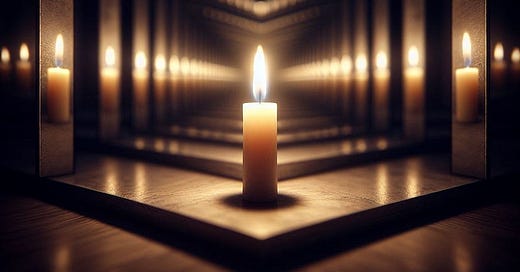Vedanta’s Helpful Caress: Harmony That Heals Hamlet’s Inner Turmoil
To be, “to be able to be”, or not to be
This is Māyā, the illusory perception of multiplicity that obscures the underlying oneness of Absolute Reality— Image by Author.
“To be or not to be?”. The tormented dilemma echoes through the centuries, a vivid incarnation of human turmoil in the face of the mystery of existence. What lies behind the fleeting semblance of life? Actual reality or empty nothingness?
Shakespeare evokes wonderfully the drama of man suspended between being and not being. Hamlet symbolizes the precarious mortal condition, exposed to the arrows of fate and the voracity of time.
Being and not being
How to escape the anguish generated by the fragile earthly tenure? How to bear the wrongs of fate, the blows of outrageous fortune? Perhaps it is better to oppose it, fighting that “sea of troubles” which is existence? Or disintegrate into the “fear of something after death” which is death?
Hamlet embodies the incessant human oscillation between action and renunciation, between endurance and revolt, and between life and annihilation. He gropes, torn, between opposite possibilities, unable to unravel the existential tangle.
He is the emblem of the infinite human perplexity in the face of the enigma of reality. And such enigma spares neither great nor humble, neither wise nor foolish. Perhaps only a god could escape such ontological precariousness.
Absolute
Yet, deep down, we yearn for the Absolute. We want this torment of ours to find composition in some enduring harmony. How then do reconcile multiplicity and unity, immanence and transcendence, permanence and change?
Even the multifaceted Indian thought grappled thoroughly with this question. And it gave rise to original speculative answers, aimed at mending the tears in the world. In particular, the Vedanta school elaborated a metaphysical solution of great significance.
The Vedanta starts from a cardinal principle: there exists a supreme Being, Brahman, the origin and foundation of all things. However, Brahman is not a cold and abstract reality, but rather full of every possibility not yet expressed.
Māyā
Brahman generates Māyā — the veil of perceived reality, this overflowing fullness gives form to the universe in its multifaceted variety. But how to derive the manifold from the One, vicissitude from the immutable?
Here comes the brilliant Vedanta intuition. Between Brahman and the phenomenal world, there is an indeterminate gap, the avyakta. It is in this shadow zone that the enchantment takes shape: being mixed with non-being, the possible with the real.
Possibilities
In this shadowy place, the possibilities of being start to emerge.
The avyakta is where being and not being mingle, where what can be begins to take form.
This is the place where the possibility of being the first step out of nothingness. Here, the could-bes and may-bes distil before taking on distinct shapes in the world.
Here Māyā operates its concealment: it veils the unitary vision of Brahman and at the same time makes it accessible in the plurality of forms. Not two contrasting principles, but an infinite source that refracts itself in the cosmic becoming.
Obscuring
Because of this obscuring of the underlying reality, the indivisible seems to split into the manifold. This is how human existence oscillates between fulfilment and lack, forgetting its divine nature.
We err in the intermezzo that separates and connects Brahman and the phenomenal world. Deprived of unitary intuition, we grope suffering among the fleeting shadows of reality.
This is Māyā, the illusory perception of multiplicity that obscures the underlying oneness of Brahman.
But Vedanta does not condemn existence: it reveals its subtle plot. In the light of non-duality, reality and appearance compose themselves into a multifaceted fabric woven by the divine. One must abandon the certainties of intellect to welcome the unspeakable mystery.
And…so?
When this awareness emerges, everything regains meaning. The universe is not a vain illusion, but a vibrant epiphany of the Absolute in the multiplicity of forms. Not alienating Maya, but a divine game in which all participate.
Reconciled with the ultimate foundation of reality, we can finally dissolve anguish in the rhythm of nature. Hamlet gropes unresolved in doubt; we dance in the intermezzo!
To be, “to be able to be,” or not to be.
What do you think about my perspective?
Feel free to leave a comment.
I have woven tales to share, for any who care to read them. My books await you on Google Books. Check also my stories on Medium.com.
I would be honoured if you considered subscribing to the Premium Contents of my Vedanta Substack and leaving feedback, comments, and suggestions both on this page and by writing to me at cosmicdancerpodcast@gmail.com.
Thank you for reading.




